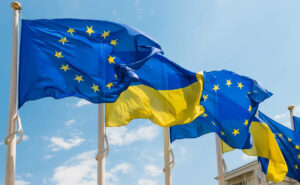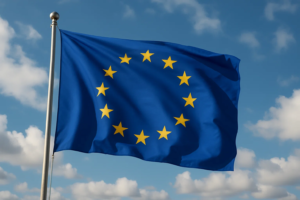
Ukraine may export an additional 46,000 tons of sugar to the EU as early as 2025, according to a statement by the National Association of Sugar Producers of Ukraine “Ukrtsukor” on its Telegram channel.
The industry association recalled that on October 29, 2025, an updated trade agreement between Ukraine and the European Union came into force, which provides for a 400% increase in the tariff quota for white sugar to 100,000 tons. As part of the agreements reached, the quota for the current year has also been revised, which will allow Ukrainian sugar producers to export an additional 46,625.8 tons of white sugar to the EU by the end of 2025.
According to Cabinet of Ministers Resolution No. 1368 of October 29, 2025, this volume will be distributed among exporters in proportion to the volume of exports of the specified products to the EU during January-May 2025.
Ukrtsukor specified that in October 2025, Ukraine exported 44.4 thousand tons of sugar worth over $20 million, of which only 2% was supplied to EU markets. Lebanon was the leader in terms of export volume, receiving 48% of all sugar. Syria and North Macedonia were also among the top three importers of Ukrainian sugar in October.

According to Eurostat, as of the end of July 2025 there are 4,373,455 citizens of Ukraine under temporary protection in EU countries. Over the month their number increased by 30,980 people, that is approximately by 0.71% compared to the June level — the dynamics are moderate but stable, indicating a continuing, though not surging, movement of people in search of safety. The overwhelming majority of beneficiaries of this regime — about 98.4% — are Ukrainians, which makes the group of aid recipients extremely homogeneous and requires focused integration measures.
The distribution by countries remains concentrated: the key burden is borne by Germany, Poland, and the Czech Republic. In Germany there are about 1,196,645 people — roughly 27.8% of the total; in Poland — about 992,505 people (around 23%); in the Czech Republic — about 378,420 people (about 8.8%). Taken together this is almost three-fifths of all recipients of protection, therefore it is precisely these economies and their social systems that first react to any changes in inflow: in large agglomerations the issues of housing affordability become acute, the need for school places and language courses grows, and municipal budgets face continuous obligations.
In such conditions, reception policy inevitably shifts to an integration agenda. Coming to the fore are the accelerated recognition of qualifications, intensive language programs, access to kindergartens and schools, as well as reskilling instruments. The labor market becomes the main shock absorber: the faster people move into formal employment, the lower the budgetary burden and the more noticeable the multiplier effect for domestic demand. At the same time, the housing issue remains the key risk: concentration in capital and industrial regions pushes rental rates upward and increases social tension. Effective responses appear to be targeted rent subsidies, accelerated renovation and construction of social housing, as well as a more even distribution of placements among municipalities.
Finally, the predictability of financing and interagency coordination at the EU and national government levels becomes critically important. Even with the current “soft” monthly increase, unreliable sources of funds quickly turn a manageable situation into a problem for local budgets. On the horizon of the coming months, the key indicators of resilience will be the growth rates of protection beneficiaries, the share of those employed, indicators of school and preschool integration, the dynamics of rental rates in concentration regions, and the speed of transition from emergency measures to long-term programs. Overall, the picture of stable but continuing growth with high concentration in Germany, Poland, and the Czech Republic requires shifting efforts from short-term aid to systemic integration — precisely this will make it possible to reduce budgetary costs and turn the humanitarian response into a sustainable socio-economic result.
EU, GERMANY, HOUSING, Labor market, MIGRATION, POLAND, REFUGEES, SOCIAL POLICY, TEMPORARY PROTECTION, UKRAINIANS

European Union leaders, noting Ukraine’s fulfillment of the conditions for opening negotiation clusters on EU accession, did not take the relevant decision due to Hungary’s position.
This follows from a statement on the conclusions agreed upon by 26 EU member states, except Hungary, following the consideration of the Ukrainian issue at the European Council meeting in Brussels on Thursday.
“The European Council reaffirms the EU’s unwavering support for Ukraine’s path to EU membership and welcomes the significant progress Ukraine has made so far under the most difficult circumstances,” the statement on the conclusions says.
In this regard, the European Council called on Ukraine, the Council, and the Commission to continue working on the accession process in accordance with a merit-based approach.
“The fundamental issues cluster will be opened first and closed last, and the clusters will be opened after the conditions have been met, in accordance with the enlargement methodology. The European Council takes note of the Commission’s assessment that the fundamental issues, internal market, and external relations clusters are ready to be opened,” the statement said.
The European Council will return to this issue at its next meeting.

The European Union is discussing the possibility of accepting new member states without granting them a full set of rights, including the right of veto, in order to speed up the enlargement process. This was reported by Politico, citing diplomatic sources in Brussels.
According to the publication, the proposal is at an early stage and requires unanimous approval from all 27 member states. Under the plan, candidate countries would be able to enjoy the main benefits of membership — access to the single market, EU funds, and political programs — but would only be granted veto rights and participation in certain decisions after the completion of institutional reforms in the European Union.
This refers, in particular, to a gradual transition from the principle of unanimous voting to a qualified majority mechanism, which would make it possible to bypass blockages by individual states.
Anton Hofreiter, chairman of the Bundestag’s European Affairs Committee, said that future members should “temporarily waive their veto rights until internal EU reforms are completed.”
“We cannot allow one or two countries to slow down the expansion of the Union,” the German MP stressed.
According to Politico, Austria and Sweden are among the supporters of the initiative, believing that such an approach would help overcome resistance from Budapest and some other capitals that fear losing influence and economic positions.
However, the idea has already met with resistance not only from Hungary, but also from France and the Netherlands, where concerns have been expressed about the “erosion” of the principle of equal membership.
Montenegro’s President Jakov Milatović commented to the publication that the enlargement process “needs to be revitalized,” recalling that Croatia was the last country to join the EU more than ten years ago.
European Commission President Ursula von der Leyen previously stated that EU enlargement remains a strategic priority and that Ukraine and Moldova could potentially join by 2030. However, most member states are currently refraining from speeding up the process.
On Wednesday, October 22, a summit will be held in London as part of the Berlin Process, where EU leaders will discuss with representatives of the Western Balkan countries further steps towards the region’s integration into the European Union.
According to Politico sources, the European Commission is also considering the option of conducting separate stages of negotiations with candidates without the need for unanimous agreement from all members, which would allow it to circumvent the risk of a blockade, primarily from Hungary.
Currently, Ukraine, Moldova, Serbia, Montenegro, North Macedonia, Albania, and Bosnia and Herzegovina have the status of candidate countries for EU membership. Turkey has been negotiating membership since 2005, but the process is effectively frozen.

Ukrzaliznytsia (UZ), subject to European and state co-financing, plans to implement the Mostytska-Sknyliv project in the next two years and further develop the Lviv-Uzhhorod -Chop and Lviv-Chernivtsi-Vadul-Siret (Romania), which will allow Ukraine to begin restoring and realizing its unique geographical status, said Oleg Yakovenko, director of the strategy and transformation department at Ukrzaliznytsia.
“We also plan to obtain grant funds for the Mostyska-Sknyliv project, which will connect 80 km of European gauge track between the Polish border and Lviv. Next, we are currently conducting technical and economic studies on the corridors connecting Lviv, Chernivtsi, and Romania,” Yakovenko said during the Kyiv International Economic Forum (KIEF) on Thursday, October 16.
According to him, as part of Ukraine’s integration into the European Union, UZ plans to develop 1435 mm gauge railways and European transport corridors on the territory of Ukraine. The European integration reform of the railway industry also envisages a radical change in the functioning of the entire railway model in Ukraine.
“First of all, we are talking about market reform, which involves separating the infrastructure operator within Ukrzaliznytsia from the transport operators. This will allow us to liberalize the market in the future. It will also allow us to create market mechanisms specifically for transport,” Yakovenko explained.
He named the introduction of European rules on technical compatibility and interoperability as another element of the reform. This concerns technical safety standards, as well as changes to the safety management system.
The director of the strategy and transformation department at Ukrzaliznytsia noted that a draft law “On the safety and interoperability of Ukraine’s rail transport” is currently planned to be submitted for adoption by the end of the year, while next year the company expects a law on market liberalization to be introduced.
As Yakovenko explained, it is expected that a so-called infrastructure access tariff will be formed, according to which market participants will be able to purchase certain access to transport routes from the infrastructure operator on a competitive basis.
“These tariffs will be regulated, i.e., they will be formed in accordance with the tariff formation procedure and will reflect economically justified tariffs in accordance with European rules,” emphasized the representative of Ukrzaliznytsia.
It is noted that the new system will introduce separate PSO (Public Service Obligation) contracts between passenger carriers and the state at the national level, as well as between carriers and local authorities. This should remove the financial burden from freight transport.
As reported, in September, a section of standard (“European”) 1435 mm gauge railway was opened between Uzhhorod and Chop in Zakarpattia Oblast, which will allow for direct rail connections between Uzhhorod and a number of European capitals.
In addition, in January 2025, it was reported that the reconstruction of the railway track on the section “Polish State Border – Mostyska II – Sknyliv (Lviv)” would be postponed until 2026, although in February 2024, the then Deputy Prime Minister for Recovery – Minister of Community, Territory and Infrastructure Development Oleksandr Kubrakov announced the start of construction by the end of 2024. Later it became known that Ukraine had failed to attract Connecting Europe Facility (CEF) funding for the project. It was reported that the US Agency for International Development (USAID) was considering financing 50% of the project’s cost, but it has since been liquidated.
CONSTRUCTION, EU, European gauge, GRANT, LVIV, UKRZALIZNYTSIA

Global demand for steel in 2025 will remain at the previous year’s level — about 1.748 billion tons, after a 1.6% decline in 2024. These figures are given in the short-term forecast of the World Steel Association (Worldsteel) — Short Range Outlook (SRO).
In 2026, according to experts, demand will grow by 1.3% to 1.772 billion tons, driven by recovery in Europe, India, and the rapidly developing countries of Asia, the Middle East, and Africa.
According to Worldsteel’s forecast, in the CIS countries, including Ukraine, demand for steel will decline by 5.2% in 2025, to 56.1 million tons, and by another 1.7% in 2026, to 55.2 million tons.
At the same time, India will retain its status as the world’s fastest-growing steel market, with growth of around 9% annually in 2025-2026. Already next year, steel consumption in India will be almost 75 million tons higher than in 2020.
In developing countries (excluding China), demand for steel will increase by 3.4% in 2025 and by 4.7% in 2026, driven by active economic development in ASEAN countries, as well as in Saudi Arabia and Egypt.
In Africa, steel consumption is growing by an average of 5.5% annually, reaching 41 million tons in 2025 — the highest level in the last decade. Growth is driven by investments in construction and improved macroeconomic indicators.
Andriy Ozeychuk, Chairman of the Board of Directors of the Ukrainian Steel Construction Center and Director of Rauta, commented on the market situation and prospects for the Ukrainian steel sector.
“The Ukrainian steel market in 2025–2026 will be shaped by the recovery of domestic demand in construction and machine building, as well as the growth of exports of metal structures to the EU. We predict that demand for steel in Ukraine may grow by 6-8% in 2026 due to infrastructure and industrial recovery projects,” Ozeychuk said.
According to him, the steel construction sector will be the driver of this growth:
“The use of metal structures will accelerate the restoration of logistics, industrial, and infrastructure facilities.”
Ozeychuk also stressed that the launch of joint programs with European partners in the field of “green” metallurgy, where Ukraine already has its first pilot initiatives for the production of steel with a low carbon footprint, could give the industry an additional boost.
According to the forecast, demand for steel in the EU+UK region will increase by 1.3% in 2025 and by 3.2% in 2026. This reflects the impact of increased investment in infrastructure and defense amid lower inflation and improved household incomes.
In the US, Worldsteel expects steel consumption to increase by 1.8% in both 2025 and 2026. The main drivers of growth will be government spending on infrastructure, a revival in housing construction, and private investment.
In China, steel demand will continue to decline, by approximately 2% in 2025, due to the prolonged downturn in the real estate market. In 2026, the rate of decline will slow to 1% as the construction sector is expected to bottom out.
Worldsteel warns that a more challenging global trade environment and financial pressure on local authorities could further limit infrastructure investment and reduce demand.
According to Alfonso Hidalgo de Calcerrada, chief economist of the Spanish Steel Manufacturers Association (UNESID) and chairman of the Worldsteel Economic Committee, the organization is “cautiously optimistic” about the market outlook:
“Despite trade disputes and uncertainty, we believe that global steel demand will bottom out in 2025 and show moderate growth in 2026,” the expert said.
He added that this will be facilitated by the resilience of the global economy, growth in infrastructure investment, and easing financial conditions. At the same time, the sector continues to be pressured by high costs, trade barriers, and geopolitical risks.
Worldsteel’s forecast emphasizes that the decline in demand in China is offset by strong growth in India and developing countries, where a new center of global steel production is emerging.
In addition, the protective measures introduced by the European Union — reducing duty-free import quotas and increasing customs duties to 50% — may change the balance between EU producers and exporters from Asia and Eastern Europe.
For more information on the largest steel producers and global industry trends, see the Experts Club video analysis review available on YouTube: Experts Club — Leaders of the global steel industry 1990–2024
CHINA, EU, EXPERTS CLUB, global economy, INDIA, OZEYCHUK, RAUTA, USA, World Steel, WORLDSTEEL